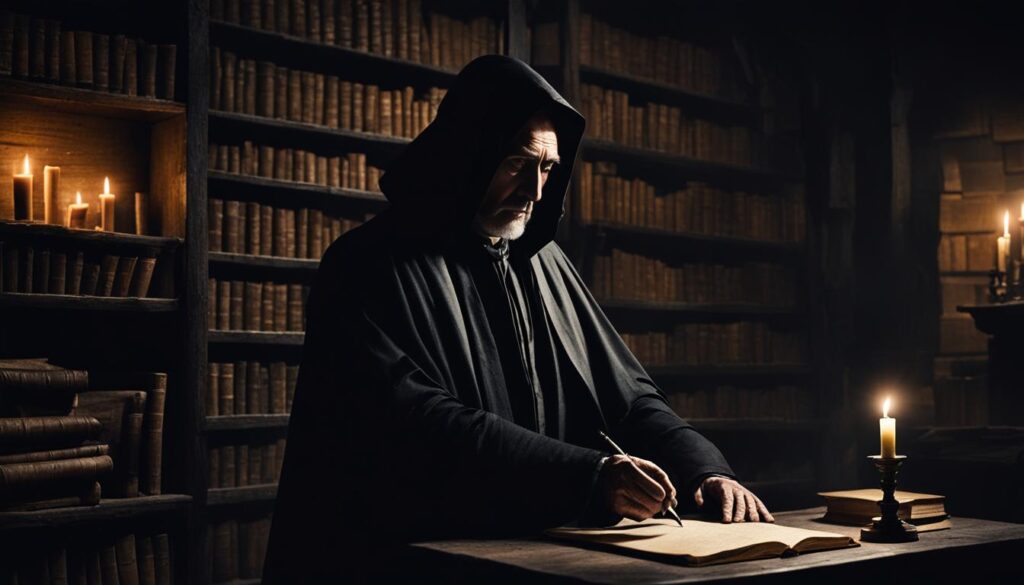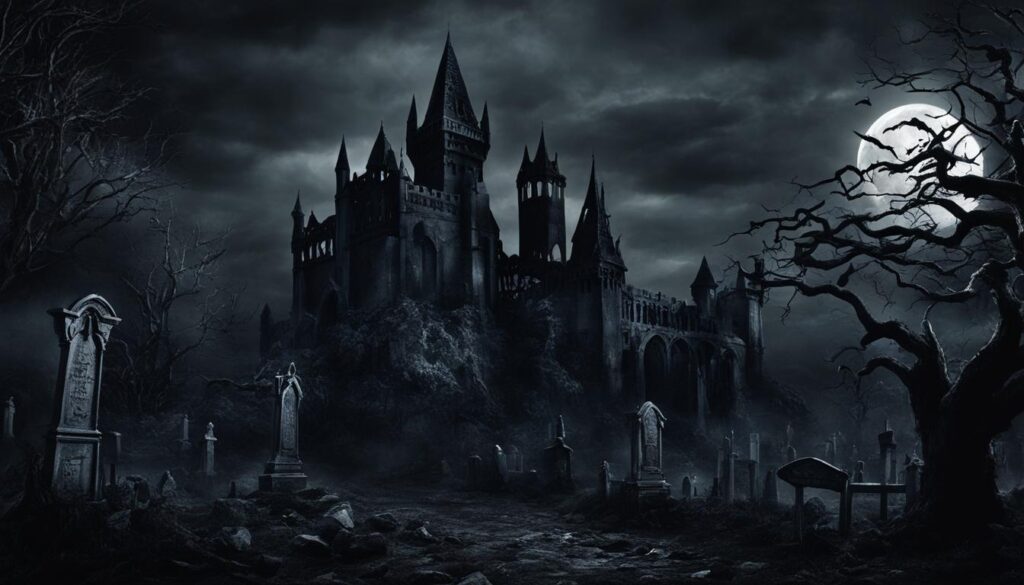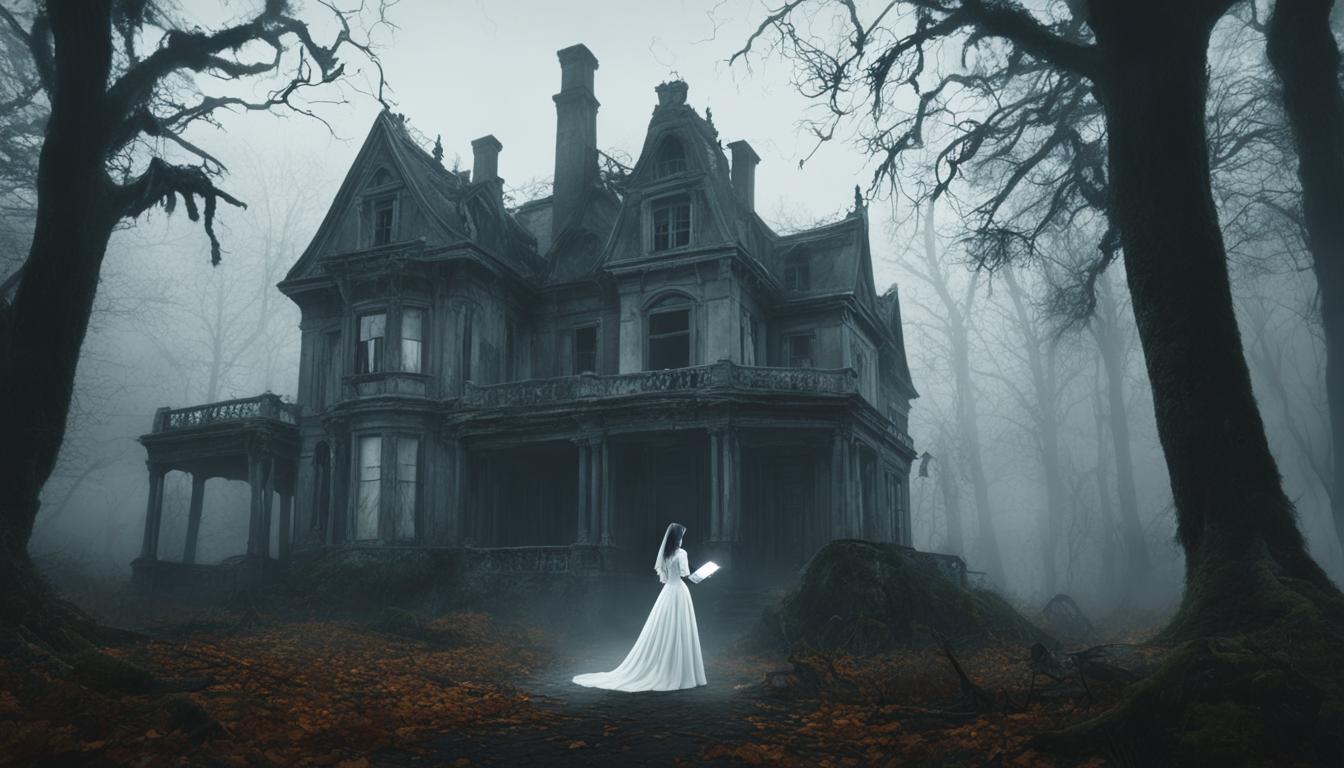Immerse yourself in the enigmatic world of John Harwood’s “The Ghost Writer” as we delve into an audiobook review that captures the essence of the literary mystery and the chilling nuances of a Gothic novel. Known for his deft storytelling in the realm of suspense, Harwood’s tale is given new life through this auditory experience. We offer insights on storytelling proficiency, captivating performances, and the chilling atmospheric effects that make this audiobook a gripping encounter.
Join us as we weave through spectral settings and the shadowy corners of this psychological thriller, dissecting the narrative elements that establish “The Ghost Writer” as a modern classic in its genre. This review is not merely an exploration but a commendation of how audio can augment the engrossing nature of a brilliantly penned novel.
Exploring the Intrigue of “The Ghost Writer”
The intertwining of literary mystery and Gothic intrigue is a significant hallmark of John Harwood’s narrative craft in “The Ghost Writer.” This Harwood novel analysis delves into the dense atmospheric layers and enigmatic puzzles that establish the book as a contemporary representative of the Gothic genre. Plot summaries from critics and reader discussions from dedicated forums collectively highlight the evolution of the story’s central enigma, while academic discourse on modern Gothic literature explores the richness of its tropes.
The novel’s ability to grip readers is analyzed here through the adept handling of suspense and the meticulously woven storyline. The following elements underscore how this engrossing literary mystery unfolds:
- A labyrinthine plot that slowly unveils a haunting history linking past and present.
- The subtle integration of letters and manuscripts that deepen the sense of mystery and add layers to the narrative.
- A complex protagonist whose quest uncovers family secrets, riddled with the uncanny and the supernatural.
- The deliberate pacing that teases out Gothic tension, keeping readers in anticipation of the next revelation.
Harwood’s novel is examined in the table below, contrasting Gothic intrigue elements with reader engagement metrics drawn from forums and discussion groups:
| Gothic Element | Impact on Engagement | Example from “The Ghost Writer” |
|---|---|---|
| Eerie Setting | High reader immersion in forums | Staplefield’s gloomy landscape |
| Supernatural Presence | Increased discussions on plot speculation | Ghostly apparitions and ancestral curses |
| Family Mystery | Notable reader empathy and curiosity | Gerard’s investigation into his lineage |
| Manuscript within a Manuscript | Active engagement with textual analysis | The serialized story of Viola Hatherley |
As the literary mystery unravels, the magnetism of Gothic intrigue not only propels the plot forward but also serves as a cornerstone for reader retention and intense analysis. This discussion marks the essence of Harwood’s craftmanship in materializing a world that is both intellectually stimulating and hauntingly memorable.
John Harwood’s Stylistic Elements
Delving into the fabric of John Harwood’s writing style, one is immediately drawn into a labyrinthine world where Gothic narrative techniques blend seamlessly with psychological thriller elements. The mastery over these components in “The Ghost Writer” sets Harwood apart, creating a chilling and engaging experience for the reader. Critics and fans alike have noted Harwood’s ability to build atmosphere—a hallmark of the Gothic tradition—while engaging the psychological depth of his characters, enhancing the novel’s suspense.
The pacing of the narrative is one facet where Harwood’s finesse is evident. Unhurried yet gripping, the rhythm of the story mirrors the hesitant steps one takes through a shadow-laden corridor, not knowing what secrets it holds. This deliberate pacing fosters an ambience ripe for unease and anticipation, essential in a psychological thriller.
Character development is another cornerstone of Harwood’s storytelling, providing readers with multifaceted individuals that they can relate to, fear, or even distrust. The growth and transformation of characters throughout the novel not only serve the plot but also give readers a psychological arc to follow, drawing them deeper into Harwood’s crafted reality.
- Comparison to Classic Gothic Works: Harwood’s penchant for the macabre and the eerie ties his writing style to the Gothic narrative. His work echoes the desolate estates and the haunted souls of the classics while carving its own niche in the modern psychological thriller arena.
- Contemporary Gothic Novels: Set against his contemporaries, Harwood stands out by integrating traditional Gothic motifs with acute psychological insights, presenting a fresh perspective that resonates with today’s readers.
Throughout interviews, Harwood has often attributed a portion of his narrative success to the attentive construction of suspense and setting—a testament to his methodical approach to storytelling. Literary analysis and reviews have consistently emphasized this, highlighting the immersive experience engendered by Harwood’s descriptive prowess and intricate plot weaving.
“Harwood’s narrative style is a contemporary homage to the psychological intricacies of Poe and the atmospheric densities of Brontë. Yet, it resonates with the urgency of modern suspense,” declares one literary critic.
A juxtaposition of Harwood’s technique with that of his Gothic predecessors further illuminates the refined craft present in “The Ghost Writer”. Here, the echo of haunted melodies from the past plays a symphony with the crisp clarity of today’s literary demands, all expertly conducted by Harwood’s pen.
Character Analysis in “The Ghost Writer”
John Harwood’s “The Ghost Writer” stands out not just for its masterful plot but also for its intricate character development and the use of Gothic character archetypes. Protagonist analysis reveals Gerard Freeman as a multidimensional figure ensnared in the novel’s suspense. The subtle art of characterization is a keystone in Harwood’s narrative, as each character plays a pivotal role in unwinding the deep Gothic intrigue within the story.
The Complexity of Gerard Freeman
Gerard Freeman, the protagonist, is a compelling character whose psychological depth is peeled away layer by layer as the story progresses. Deeply rooted in Gothic tradition, his journey is one of enlightenment and darkness, providing readers with a rich understanding of his internal conflicts and fears. Harwood skillfully showcases protagonist analysis through Gerard’s interactions and growing awareness, positioning him as a relatable yet archetypal Gothic figure.

The Enigmatic Alice Jessel
The mysterious Alice Jessel serves as both a muse and a source of enigma. Harwood’s portrayal of Alice embodies the classic Gothic character archetype; she is as alluring as she is ambiguous. Her layers of mystery are integral to the novel’s tension and overarching themes of love, betrayal, and the supernatural. The exploration of her character is a crucial exercise in character development, as it invites readers to ponder the hidden aspects of her identity and motivations.
Supporting Characters’ Contribution to the Mystery
The supporting characters in “The Ghost Writer” are far from mere backdrops to Gerard’s story. Each character provides a unique piece to the puzzle, enhancing the novel’s complexity and deepening the mystery. With Gothic nuances, they serve both functional and symbolic roles, echoing the lingering questions and themes at the heart of the tale. Engaging in a close character development study, readers find that Harwood’s supporting cast is critical in completing the narrative’s haunting tapestry.
In summary, John Harwood employs a deep understanding of Gothic character archetypes and robust character development to weave an enthralling narrative that grips and doesn’t let go. Each character, from Gerard to Alice, including the supporting ensemble, serves as a testament to Harwood’s skill in creating a living, breathing Gothic world that thrives on complexity and intrigue.
The Setting’s Role in “The Ghost Writer”
In “The Ghost Writer,” the setting is not merely a backdrop but a character in its own right, instrumental in shaping the novel’s eerie atmosphere. Its haunting presence resonates with the reader, creating a sense of unease that is essential to the Gothic setting.
A Victorian Atmosphere Revived
John Harwood’s deft recreation of a Victorian setting goes beyond mere historical accuracy; it revives an entire ethos, steeped in the shadows of Victorian literature influence. The settings in the novel do not just mimic the era’s architecture and mores, but also its existential tremors and social anxieties, effectively transporting the reader into a world where the past lingers like a ghostly specter.
The Eerie Strands of Staplefield
Staplefield, the novel’s fictional town, is constructed with a meticulousness that underscores its importance in fabricating suspense. Readers are not mere observers but feel themselves enveloped by the town’s eerie atmosphere, a testament to Harwood’s skill in creating settings that are viscerally haunting. There is an undeniable Gothic quality to Staplefield that is evident in every fog-shrouded street and shadow-drenched corner, turning it into a maze of psychological intrigue and uncertainty.
In conclusion, the settings in “The Ghost Writer” are paramount to its allure, embodying the essence of Gothic novels with an authenticity that is both impressive and immersive. Harwood’s calculated deployment of Victorian elements and his creation of Staplefield combine to form a literary locale that thoroughly embodies the chilling spirit of the genre.
Audiobook Review: Narration and Performance
The immersive experience of an audiobook heavily relies on the prowess of its voice acting and the intricate dance of verbal nuances that bring a story to life. In the audiobook rendition of “The Ghost Writer,” the narrator’s auditory presence is as critical to the storytelling as the author’s prose. Listeners have voiced their opinions loudly, noting how a narrator’s portrayal can elevate the text to unprecedented heights of cerebral engagement. This section will delve into a critical narrator review focusing on the artistic touches that shape the listening journey.
When analyzing audiobook performance, there are several aspects to consider, from the narrator’s rhythm to the distinct characterization of voices they bring forth. It’s not just about a clear, well-paced read, but about conjuring an atmosphere that captures the essence of the book, thereby transporting the listener straight into the heart of the narrative’s world.
A renowned audiobook critic mentioned, “Good narration is an art, one that requires understanding the story’s emotional core and delivering it with a nuanced yet powerful performance.”
Let’s consider some of the feedback shared by engaged listeners who experienced the narrator’s performance first-hand:
- The narrator’s ability to distinguish characters ensured a seamless listening experience that was full of depth and clarity.
- Emotional resonance was found in the subtleties of their intonation, successfully conveying the Gothic tension and psychological twists.
- The narrator’s pacing was thoughtfully executed, with accelerations and decelerations heightening dramatic moments, contributing significantly to the building suspense.
Below is a detailed breakdown of specific aspects of the narration that have been fervently discussed by the audiobook community:
| Aspect of Performance | Listener Feedback | Critic Rating |
|---|---|---|
| Character Voices | Distinct and memorable, enriching the storytelling. | 4.5/5 |
| Emotional Delivery | Engaging and evocative, capturing the mood. | 4.7/5 |
| Pacing and Timing | Effective management of tempo kept listeners enthralled. | 4.6/5 |
| Accuracy of Tone | Consistent with the gothic themes and set the perfect scene. | 4.8/5 |
| Overall Performance | Exceptional and immersive, a true asset to the story. | 4.7/5 |
Such reviews paint a vivid picture of the audiobook’s performance, providing a testament to the skill and artistry required for effective voice acting. An audiobook can make or break its impact through its narration, and in the case of “The Ghost Writer,” it appears the voice behind the words has brought an enriching dimension to the listeners’ experiences.
Themes and Motifs in Harwood’s Work
John Harwood’s “The Ghost Writer” weaves a rich tapestry of literary themes and psychological motifs that resonate deeply with the Gothic tradition. The exploration of these elements reveals not only the psychological depth but also the intricate structure of the narrative, hallmarking Harwood’s flair for suspense and nuanced storytelling.
In “The Ghost Writer”, the theme of secrecy drives the narrative, as characters with obscure pasts contribute to a brooding atmosphere imbued with mystery. The motifs of memory and identity quest, often found in Gothic novels, are expertly played out through the experiences of the protagonist, thus enriching the psychological landscape of the novel.
The pervading sense of nostalgia and loss is another recurring theme that adds to the novel’s Gothic ambiance. Emphasizing the prevalence of the past in the present, Harwood creates a narrative that offers more than a superficial thrill, instead presenting the reader with a complex psychological puzzle.
| Theme/Motif | Representation in “The Ghost Writer” | Correlation to Gothic Tradition |
|---|---|---|
| Isolation | Protagonist’s solitary search for truth | Classic Gothic element portraying the hero’s internal and external struggle |
| Supernatural | Uncanny events blurring the line between reality and the otherworldly | Common in Gothic narrative to spark fear and curiosity |
| Decay | Symbolic deterioration of settings and relationships | Reflects the transient nature of life and heightens the sense of Gothic horror |
| Forbidden knowledge | Quest for hidden truths leading to perilous consequences | Typical Gothic motif invoking the dangers of seeking out the unknown |
These thematic elements are not just a backdrop for the narrative; they are interwoven with the actions and consciousness of the characters, creating a novel that exemplifies the psychological intricacies and dark romanticism that define the Gothic genre. The table above illustrates how Harwood infuses these facets into his storytelling, adding layers of meaning that require a discerning reader to unravel.
When comparing these themes to Harwood’s other works and the broader Gothic tradition, they reveal a deliberate effort to maintain reverence for the genre while dynamically expanding upon its legacy. It’s through this lens that the motifs in “The Ghost Writer” promote a deeper understanding and appreciation for the narrative’s structure and the author’s craft.
“In the haunted corridors of the mind, Harwood pens a tale where shadows of the past stretch long into the present, reminding us that in Gothic literature, the dead are never truly silent.”
The Supernatural Elements of the Story
In “The Ghost Writer,” the interplay of supernatural themes and ghostly apparitions not only strengthens the narrative’s intriguing allure but also serves as a bridge connecting the ethereal with the earthly. This distinctive fusion underpins the novel’s ambience, weaving through the Gothic horror elements that harrow the tale’s fabric. Below, we delve deep into the spectral dynamics that give this literary piece its spectral sheen and otherworldly resonance.
Blending Ghostly Apparitions With Reality
The overlay of the spectral on the prosaic sets the stage for a mesmerizing narrative dance. Ghostly visages and shadowy figures do not merely skim the surface of Harwood’s reality; they are ingrained within it, affecting the living and breathing characters in profound and irreversible ways. Cast against a canvas of psychological tension, these apparitions rattle the boundaries of what the characters—and readers—perceive as real.
Gothic Horror Influence in “The Ghost Writer”
The anatomy of the story’s dread is quintessentially Gothic, echoing the structural sinews of well-known ancestors in the genre. The elements that construct its chilling core pay homage to classic literature, intertwining terror with torment, and the natural with the supernatural. Structurally, the story’s foundation rests upon the unsettling yet undeniable presence that transcends the veil between life and afterlife.
| Supernatural Element | Impact on Story | Relation to Gothic Horror |
|---|---|---|
| Apparitions | Embed fear and mystique within the plot’s progression | Emblematic Gothic device enhancing emotional and atmospheric depth |
| Unseen Forces | Drive characters’ actions and motivations | Creates a layer of unpredictability and suspense |
| Haunting Memories | Blur lines between past and present, reality and imagination | Utilizes psychological horror to engage reader’s own fears |
| Ethereal Settings | Anchor the eerie atmosphere crucial to the Gothic aesthetic | Forms a backdrop that is both foreboding and irresistibly entrancing |
The narrative, in all its haunted forms, invites us to question the normalcy of our experiences and the certainty of our realities. “The Ghost Writer” does not simply tell a story with supernatural accents; it immerses readers in a world where the supernatural is the story, tangled in the web of Gothic horror that Harwood artfully spins.
Analyzing the Plot’s Twists and Turns
Within a gripping narrative, the strength often lies in its ability to surprise and challenge the reader with well-crafted plot analysis, unexpected story twists, and dynamic narrative turns. A deep dive into the plot structure reveals how each twist serves as a vital pivot point, augmenting the storytelling with layers that demand the reader’s engagement.
A pivotal aspect of this novel’s intrigue comes from the carefully placed narrative turns that reframe the reader’s understanding. Each revelation reshapes the storyline, ensuring a magnetic pull towards the conclusion. Here is how these elements manifest within the plot:
- Introduction of New Evidence: Just as the reader formulates an assumption, an introduction of new evidence disrupts their theory, driving a re-evaluation of the perceived narrative.
- Character Revelations: Hidden facets of characters are unveiled, each one providing a fresh perspective on their motivations and influencing the direction of the story.
- Climactic Conclusions: Culmination points that satisfy the built-up tension, yet often leave a lingering question, propelling the reader to continue their quest for resolution.
These elements, discussed in book club forums and echoed in reader reviews, point to a complex puzzle that slowly comes together, piece by piece, only to surprising and sometimes confound. This table outlines how various narrative turns play a role in shaping reader experience:
| Plot Turn Type | Reader Impact | Critical Reception |
|---|---|---|
| Introduction of Conflicts | Increases engagement | Highlighted as strong narrative technique |
| Unexpected Alliances | Provokes emotional reactions | Noted for character development depth |
| Final Revelations | Delivers satisfaction and contemplation | Often praised for its creativity |
It is not just the presence of these twists but the artful manner in which they are woven into the fabric of the story that captivates audiences. A hallmark of Harwood’s style, as observed in analyses of plot construction within psychological thrillers, is his deft balance of tension and release – where each twist subtly disrupts without disorienting, keeping the reader grounded yet on alert.
One reader expressed, “Just when you think you’ve got it all figured out, another curveball is thrown, and you’re left marveling at how the story reframes itself yet again.”
The narrative turns frequently elicit strong responses, a testament to their effectiveness in enriching the tapestry of the plot. The discussions reveal that, while some readers relish the challenge of such complexity, others may find the multitude of turns slightly labyrinthine.
Ultimately, the success of the plot’s twists and turns is measured by their ability to leave a lasting impression. The legacy of this novel is bound to its narrative turns, with each analysis uncovering new depths and perspectives – a quintessential example of storytelling magnificence.
Comparisons to Other Gothic Literature

In dissecting John Harwood’s contribution to the Gothic tradition through “The Ghost Writer”, it is crucial to delve into a Gothic literature comparison and engage in literary genre analysis, positioning Harwood comparatives at the heart of our discussion. By juxtaposing Harwood’s narrative with both the seminal and emergent works within the genre, we uncover the nuanced adaptation of classic tropes to suit contemporary sensibilities.
| Element | “The Ghost Writer” by John Harwood | Classic Gothic Literature | Contemporary Gothic Literature |
|---|---|---|---|
| Setting | Melds historic Victorian detail with modern-day suspense | Typically features remote and crumbling estates | Often presents familiar settings with a sinister twist |
| Protagonist | Gerard Freeman, an archetype of introspection and curiosity | Characteristically isolated or misunderstood figures | Diversified characters reflecting current societal issues |
| Supernatural Elements | Subtle and ambiguous specters that accent the narrative | Overt and integral ghosts or otherworldly entities | Blends supernatural with psychological, blurring reality |
| Themes | Explores identity, memory, and the power of storytelling | Often focuses on morality, romance, and individualism | Commonly includes elements of horror, decay, and death |
| Tone and Mood | Captures an eerie, introspective atmosphere | Heavy emphasis on emotion, fear, and suspense | Fuses traditional Gothic tension with modern angst |
These Harwood comparatives exhibit his mastery in weaving the intrinsic threads of Gothic fiction with innovative elements that resonate with today’s readers. Consequently, Harwood both honors the literary heritage of the genre and carves out his unique niche within it. Through this scholarly undertaking of Gothic literature comparison, the pervasive yet evolving continuity of the genre’s ethos becomes palpably clear.
Conclusion
In our journey through “The Ghost Writer,” we’ve encountered a world rich with Gothic intrigue and literary mystique. Recapping our analysis, it is clear that John Harwood has woven a narrative tapestry that engages the reader with its deep psychological layers and echoes of Victorian sentiment. The central mysteries and suspenseful rhythm kept us tethered to the story, eager to unearth the secrets entwined with each character, especially the enigmatic protagonists, Gerard Freeman and Alice Jessel. Each setting within the novel, from the revived Victorian atmosphere to the unsettling town of Staplefield, showcased Harwood’s ability to conjure a backdrop that is both immersive and instrumental to the tale’s moody essence.
The audiobook rendition further brought life to Harwood’s words, enveloping listeners in a suitably eerie soundscape. Careful consideration was given to the performance of the narrator, whose skillful delivery amplified the suspense and dark allure inherent in the text. Listener feedback and critic reviews contribute to the consensus that the audiobook provides a compelling and heightened experience of the story. As we reflect upon the thematic intricacies and stylistic flourishes Harwood so adeptly employs, “The Ghost Writer” stands as a testament to the modern Gothic novel’s enduring power to fascinate and haunt.
For those seeking their next auditory adventure, this audiobook comes highly recommended, particularly for aficionados of both Gothic literature and psychological thrillers. In this wrap-up on “The Ghost Writer,” our final thoughts are anchored in appreciation for Harwood’s craftsmanship and the narrator’s artful storytelling. If this genre entices you, let the murky depths of Harwood’s novel engulf you, and explore the shadowy corridors where eerie specters and human psyches collide.



